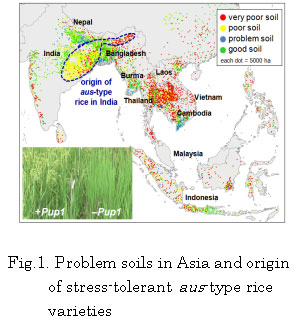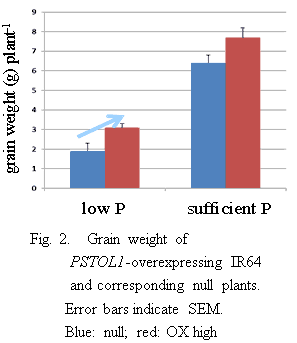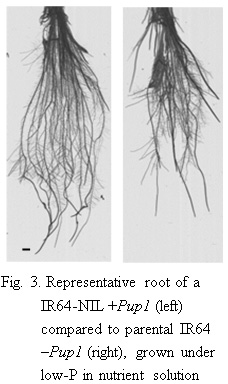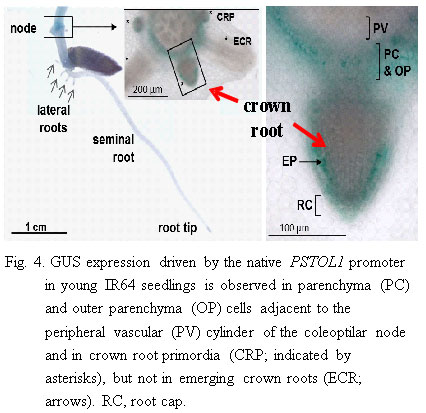The protein kinase PSTOL1 from traditional rice confers tolerance of phosphorus deficiency
Description
In Asia, around 60% (29 Mha) of the rain-fed lowland rice is produced on poor and problem soils that may be naturally low in P or P fixing (Fig. 1). Resource-poor farmers have limited access to increasingly expensive P fertilizer, and this situation may further aggravate given that phosphate rock, the source of P fertilizer, is a finite and non-renewable resource. The development of rice varieties with high productivity under low P is therefore a valid and necessary approach to improve yield and enhance food security.
The major quantitative trait locus for P deficiency tolerance, Pup1, was identified in the traditional aus-type rice variety Kasalath. Pup1-specific molecular markers revealed that the putative protein kinase gene (OsPupK46-2) was closely associated with tolerance to P deficiency in stress-adapted germplasm. This result was confirmed by qRT-PCR and thus the gene was named as Phosphorus starvation tolerance 1 (OsPSTOL1). An in-vitro phosphorylation assay confirmed that OsPSTOL1 is a functional Ser/Thr protein kinase.
Phenotypic analyses of transgenic lines with constitutive overexpression (OX) of the full-length OsPSTOL1 coding region (35S::OsPSTOL1) in varieties IR64 (indica) and Nipponbare (japonica) showed that high expression of the OsPSTOL1 transgene (OX high) enhanced grain yield by about 30% under low P conditions (Fig. 2). The superior performance of IR64 OX-high lines was due to higher root dry weight and subsequent experiments in nutrient solution showed that total root length and root surface area were significantly higher in transgenic seedlings. This was confirmed for near isogenic lines (NILs) in an IR64 background: IR64-NILs +Pup1 showed significantly enhanced root growth (Fig. 3).
Transgenic IR64 plants expressing the GUS-reporter gene under the control of the native OsPSTOL1 promoter were used to analyze the OsPSTOL1 expression (Fig. 4). Specific GUS staining was detected in stem nodes (crown roots) of young seedlings, while within nodes, GUS staining was restricted to crown root primordia and parenchymatic cells located outside of the peripheral vascular cylinder. No GUS staining was observed in older, emerging crown roots or in the initial (seminal) seedling root. Taken together our data suggest that OsPSTOL1 is a regulator of early crown root development and growth in rice.
Pup1-rice varieties developed by marker-assisted breeding will be beneficial not only under low P conditions but in a wider range of rice environments, since plants with vigorous root may show improved crop establishment and weed competitiveness. This may contribute to food security and to establishing more sustainable rice production systems.
Figure, table
-
Reference : Gamuyao et al., 2012. Nature 488, 535–539.
- Affiliation
-
Japan International Research Center for Agricultural Sciences Crop, Livestock and Environment Division
- Classification
-
Administration A
- Research project
- Program name
- Term of research
-
(FY 2008-FY 2010, FY 2011-FY 2015)
- Responsible researcher
-
Wissuwa Matthias ( Crop, Livestock and Environment Division )
KAKEN Researcher No.: 90442722Tanaka Pariasca-Juan ( Crop, Livestock and Environment Division )
Gamuyao R. ( International Rice Research Institute )
Chin Joong Hyoun ( International Rice Research Institute )
Catausan S. ( International Rice Research Institute )
Dalid C. ( International Rice Research Institute )
Slamet-Loedin I. ( International Rice Research Institute )
Heuer S. ( International Rice Research Institute )
Pesaresi P. ( University of Milan )
Tecson-Mendoza E. M. ( University of the Philippines Los Baños )
- ほか
- Publication, etc.
-
Gamuyao et al., 2012. Nature 488, 535–539.
- Japanese PDF
-
2012_16_A4_ja.pdf595.41 KB
- English PDF
-
2012_16_A4_en.pdf430.07 KB




